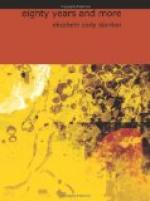On August 20, I returned to Toulouse and our quiet convent. The sisters gave me a most affectionate welcome and I had many pleasant chats, sitting in the gardens, with the priests and professors. Several times my daughter and I attended High Mass in the cathedral, built in the eleventh century. Being entirely new to us it was a most entertaining spectacular performance. With our American ideas of religious devotion, it seemed to us that the people, as well as the building, belonged to the Dark Ages. About fifty priests, in mantles, gowns, and capes, some black, some yellow,—with tinseled fringes and ornamentation,—with all manner of gestures, genuflections, salutations, kneelings, and burning of incense; with prayers, admonitions, and sacraments, filled the altar with constant motion.
A tall man, dressed in red, wheeled in a large basket filled with bread, which the priests, with cups of wine, passed up and down among those kneeling at the altar. At least half a dozen times the places at the altar were filled—chiefly with women. We counted the men,—only seven,—and those were old and tremulous, with one foot in the grave. The whole performance was hollow and mechanical. People walked in, crossed themselves at the door with holy water, and, while kneeling and saying their prayers, looked about examining the dress of each newcomer, their lips moving throughout, satisfied in reeling off the allotted number of prayers in a given time. The one redeeming feature in the whole performance was the grand music. The deep-toned organ, whose sounds reverberated through the lofty arches, was very impressive.
The convent consisted of three large buildings, each three stories high, and a residence for the priests; also a chapel, where women, at their devotions, might be seen at various hours from four o’clock in the morning until evening. Inclosed within a high stone wall were beautiful gardens with fountains and shrines, where images of departed saints, in alcoves lighted with tapers were worshiped on certain days of the year.




